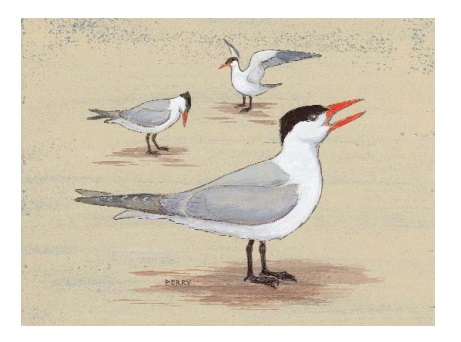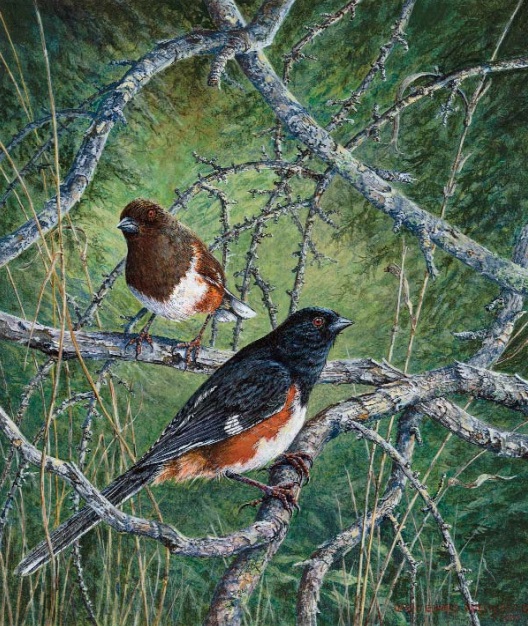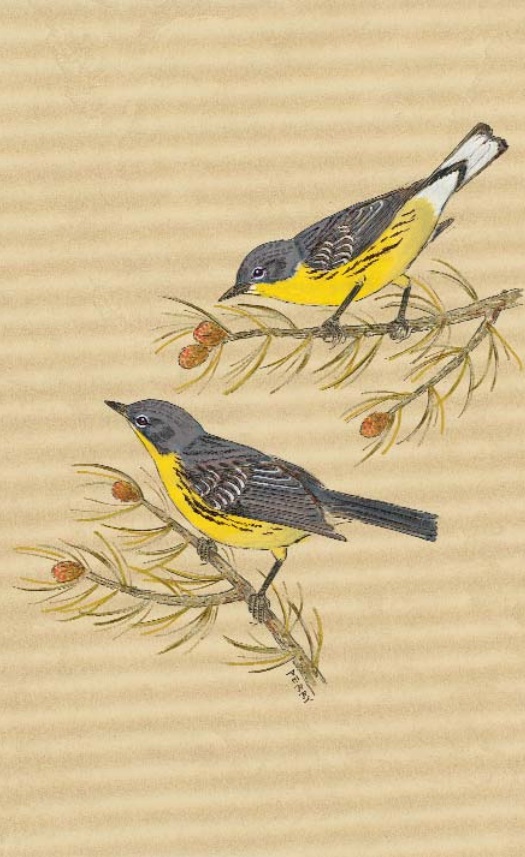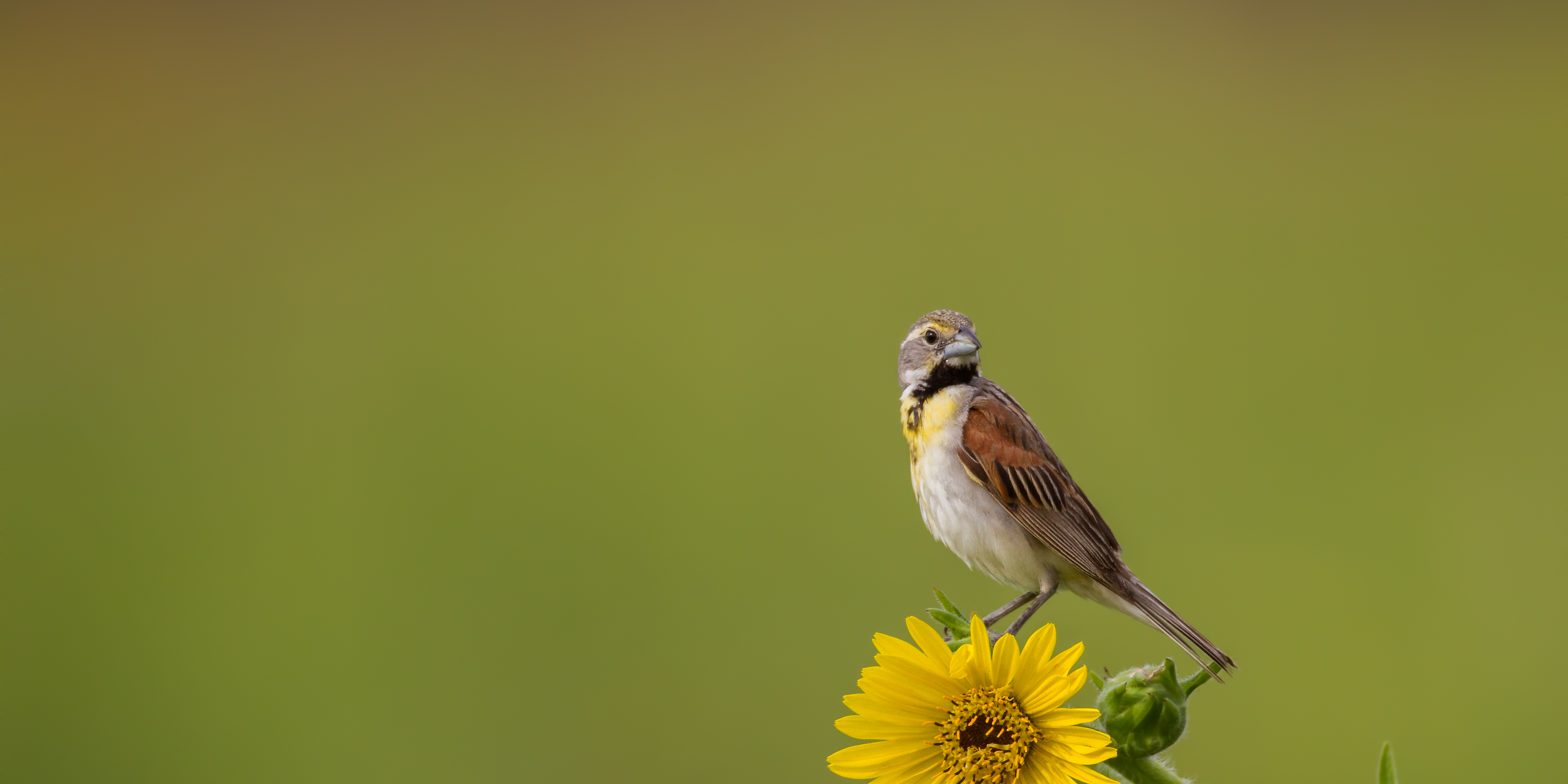Originally compiled and edited by Daryl D. Tessen and published by the Wisconsin Society for Ornithology - 2009.
Dedicated to Thomas Schultz and his outstanding contributions to Wisconsin ornithology and art.

Birders can enjoy the many ornithological treats that Wisconsin offers within this fifth edition of Bird Haunts. The 145 articles and 1100 areas detail the excitement of watching jaegers (Parasitic, rarer Pomarine and rarest Long-tailed) harassing the thousands of gulls on Wisconsin Point during September or finding other rarities along the two mile peninsula; hearing/seeing the booming Greater Prairie Chickens on their leks in the predawn spring on the Buena Vista Grasslands; the May/June chorus of Kentucky, Cerulean, Prothonotary and Yellow-throated Warblers plus other migrant/breeding passerines in the woods of Wyalusing State Park; at Crex Meadows viewing the Sharp-tailed Grouse dancing on their leks during April/May while in October/November watching the impressive gathering of Sandhill Cranes; the fall concentration of 200,000+ Canada Geese plus other waterfowl in and around Horicon Marsh; and last, in the northern forests the haunting cry of the Common Loon from the many lakes during the summer while in winter the beauty of these north woods highlighted during irruptive years by winter finches and Bohemian Waxwings plus resident Gray Jays, Boreal Chickadees and Black-backed Woodpeckers. Wisconsin has all this and considerably more to offer the birder who utilizes the information between these covers.
The state has a variety of habitats that are used by an assortment of birds. A brief description of each with a list of several characteristic species follows. The list is in order of habitat abundance.
WISCONSIN BIRD HABITATS
Cropland - 9,100,000 acres
Cropland features row crops such as corn, soybeans, small grains, vegetables and berries and also includes alfalfa. The reason for the last crop is due to the early and persistent cutting of the crop, which provides little habitat for grassland birds. This habitat also includes sparse fencerows, fallow areas and bare soil fields. Species include Ring-necked Pheasant, Gray Partridge (rare), Killdeer, Sandhill Crane, Horned Lark and Savannah Sparrow.
Fragmented Woodlots (etc.) - 5,400,000 acres
This includes small woodlots, vegetated fencerows, rural lots and cabin sites. In essence, it is the scattered woodlot parts of farms, large well vegetated suburban lots, densely clustered cabin sites, wooded and grassy waterways in agricultural country. Predominant habitat can be old trees or young shrubs, but the primary factor is heavy fragmentation of former contiguous habitat. Species include Wild Turkey, Cooper’s Hawk, Red-tailed Hawk, Eastern Screech Owl, Great Horned Owl, Eastern Bluebird, Brown Thrasher and Indigo Bunting.
Northern Hardwood Forests - 5,300,000 acres
This is nearly contiguous forest occupied by smaller diameter hardwoods, mostly maples, aspen and white birch, but other northern species are included. The trees are usually between 20-80 years old and have a very sparse under story and sapling layer. Gaps are infrequent due to this being the dense growth stage that self-thins as Introduction the densely packed trees compete. Species include Broad-winged Hawk, Ruffed Grouse, Black-billed Cuckoo, Yellow-bellied Sapsucker, Eastern Wood-Pewee, Redeyed Vireo, Nashville Warbler, Black-throated Green Warbler, Ovenbird, Scarlet Tanager (older trees) and White-throated Sparrow.
Open Water - 2,300,000 acres
This habitat refers to all lakes, streams and the Great Lakes with their bays and estuaries. It also includes the emergent vegetation, islets and cobble areas. Not included are deep marsh areas, wild rice marsh and backwater/oxbow areas. The habitat is used mostly for foraging and loafing. Species include geese, swans, ducks, loons, grebes, gulls and terns.
Young Deciduous Forest - 1,500,000 acres
This is nearly contiguous forest occupied by young hardwoods, mostly maples, aspen, oak and white birch, but other northern species are included. The trees are usually between 1-20 years old and have very dense coverage by saplings. Gaps are infrequent due to this being the densest growth stage. These forests often have a lot of edge between adjacent forest stands of different ages, types or from roads. Species include Ruffed Grouse, Alder Flycatcher, Eastern Kingbird, Veery, Hermit Thrush, Nashville Warbler, Chestnut-sided Warbler, Black-and-white Warbler, Mourning Warbler, Chipping Sparrow and Indigo Bunting.
Surrogate Grasslands - 1,050,000 acres
Grassland areas are comprised of predominately Eurasian grasses, such as smooth brome, Kentucky bluegrass, timothy and quackgrass. These areas are best described as Conservation Reserve Program (CRP) locations, abandoned fields and northern Wisconsin late hay harvest areas. In many cases these areas also have an abundance of Eurasian flowering plants (forbs) associated with the grass. These habitats are rather ephemeral in nature requiring regular maintenance (haying, mowing or prescribed fire) to maintain them. Species include Ring-necked Pheasant, Upland Sandpiper, Short-eared Owl (mostly winter), Sedge Wren, Vesper Sparrow, Grasshopper Sparrow, Field Sparrow, Henslow’s Sparrow (south), Le Conte’s Sparrow (north), Dickcissel (abundant forbs), Bobolink, Eastern Meadowlark and Western Meadowlark (drier areas in large open landscapes).
Mature Oak-Hickory Forest - 950,000 acres
This includes mature oak-hickory forest occupying blocks larger than 100 acres. This habitat features primarily red oak and shagbark hickory, but also includes white ash, sugar and red maple and American basswood to name a few. The trees are mostly over 80 years old and need to be in larger blocks to harbor some of the more area sensitive species. Species include Broad-winged Hawk, Great Horned Owl, Barred Owl, Whip-poor-will (edges or pure oak forests), Pileated Woodpecker, Eastern Wood-Pewee, Yellow-throated Vireo, Tufted Titmouse, Blue-gray Gnatcatcher, Wood Thrush, Cerulean Warbler, Louisiana Waterthrush (streams within the forest), Hooded Warbler (dense shrubs), Kentucky Warbler (primarily southwest Wisconsin), Scarlet Tanager and Rose-breasted Grosbeak.
Mature Northern Hardwood Forest - 850,000 acres
This is mature northern hardwood forest occupying blocks larger than 100 acres. This habitat features primarily sugar maple, American basswood, yellow birch and white ash. In northeast and east central Wisconsin American beech can be a strong component of the woods. The trees are mostly over 80 years old and need to be in larger blocks to harbor some of the more area sensitive species. Species include Broad-winged Hawk, Barred Owl, Pileated Woodpecker, Eastern Wood-Pewee, Least Flycatcher, Common Raven, Winter Wren, Hermit Thrush, Veery, Wood Thrush, Black-throated Blue Warbler (dense understory), Black-throated Green Warbler, Black-and-white Warbler, Ovenbird, Canada Warbler (dense understory), Scarlet Tanager and Rose-breasted Grosbeak.
Pasture - 750,000 acres
Pasture land is comprised of actively grazed short to moderate height Eurasian grasses, most characteristically Kentucky bluegrass. Species include Red-tailed Hawk, Killdeer, Upland Sandpiper, Horned Lark, Field Sparrow (edges), Savannah Sparrow, Grasshopper Sparrow, Bobolink, Brewer’s Blackbird, Eastern Meadowlark and Western Meadowlark.
Hardwood Swamp - 700,000 acresHardwood swamp areas feature black ash and red maple with few, if any white cedar. These areas are most often found in low areas in rolling landscape, but also occupy large areas of flat ground moraine in north central Wisconsin. Isolated areas in more developed landscapes contain fewer species. Species include American Woodcock, Barred Owl, Downy Woodpecker, Hairy Woodpecker, Pileated Woodpecker, Eastern Kingbird, Black-and-white Warbler, American Redstart, Ovenbird, Northern Waterthrush, Mourning Warbler, Common Yellowthroat, Song Sparrow, Swamp Sparrow and Red-winged Blackbird.
Red Pine Plantations - 650,000 acres
Red pine plantations feature heavily managed red pine monocultures planted in rows. Not included in the species list are those found in the very young conifers that are covered under a separate category below. Species include Long-eared Owl (winter roost), Blue Jay, American Crow, Blue-headed Vireo, Least Flycatcher, Redbreasted Nuthatch (trees 30+ years old), Nashville Warbler, Yellow-rumped Warbler (north), Pine Warbler (50+ years), Ovenbird, Chipping Sparrow, Brown-headed Cowbird and Red Crossbill (50+ years).
Successional Oldfields - 640,000 acres
Oldfield succession habitats feature former agriculture areas that have been discontinued from active agriculture. These areas are in various states of natural succession to a forested landscape. They can be in upland or lowlands and often times have abundant shrubs and young trees in variable densities. Species include Ringnecked Pheasant, Northern Harrier, American Woodcock, Short-eared Owl (winter), Willow Flycatcher (south), Gray Catbird (edges), Brown Thrasher (edges), Bluewinged Warbler (south), Chestnut-sided Warbler (north), Eastern Towhee, Clay-colored Sparrow (north), Field Sparrow (south), Indigo Bunting, Eastern Meadowlark and Brown-headed Cowbird.
Shrub Swamp - 600,000 acres
Shrub swamp areas feature alder thickets, willow dominated stream courses, dogwoods and bog birch areas. Even though these areas have shrubs as dominant species, they are relatively long lasting natural communities. Case in point, the French explorers found alder thickets along the Bois Brule River in precisely the same location as they are found today. Species include Northern Harrier, Wilson’s Snipe, American Woodcock, Short-eared Owl (winter), Alder Flycatcher (north), Willow Flycatcher (south), Sedge Wren, Veery, Golden-winged Warbler, Yellow Warbler, Chestnut-sided Warbler (north), Swamp Sparrow, White-throated Sparrow (north) and Red-winged Blackbird.
Mature Northern Hemlock-Hardwood Forest - 600,000 acres
Mature northern hemlock-hardwood areas feature large contiguous blocks of forest older than 80 years. These areas are predominately occupied by sugar maple, basswood, yellow birch, eastern hemlock and white pine. The mixed forest usually has a significant understory of dense deciduous or conifer saplings. Many times dense areas of balsam fir are in the understory. Species include Ruffed Grouse, Sharpshinned Hawk, Northern Goshawk, Broad-winged Hawk, Northern Saw-whet Owl, Yellow-bellied Sapsucker, Pileated Woodpecker, Blue-headed Vireo, Red-eyed Vireo, Common Raven, Red-breasted Nuthatch, Brown Creeper, Black-throated Blue Warbler (dense understory), Black-throated Green Warbler, Blackburnian Warbler, Ovenbird, Mourning Warbler (gaps), Canada Warbler (dense understory), White-throated Sparrow and Purple Finch.
Spruce Tamarack Forest - 600,000 acres
Spruce-tamarack wet forest features the more productive portions of these wetland forest communities often referred to as bogs. The dominant species are black spruce and tamarack. Sometimes they are found as single species forests, but most often they are found together. The most productive areas will have very large trees and if they cover significant portions of the landscape they will support the most diverse species composition. Species include Spruce Grouse (if the habitat is large and is embedded in a conifer dominated landscape), Northern Saw-whet Owl, Blackbacked Woodpecker (ditto as Spruce Grouse), Olive-sided Flycatcher, Yellow-bellied Flycatcher (large trees), Gray Jay (large patches), Boreal Chickadee (large patches), Red-breasted Nuthatch, Winter Wren (older patches), Golden-crowned Kinglet, Rubycrowned Kinglet (far north), Northern Parula Warbler (old trees with moss), Magnolia Warbler, Cape May Warbler, Yellow-rumped Warbler, Connecticut Warbler (large patches), Dark-eyed Junco (far north), Purple Finch and White-winged Crossbill.
Mature Pine-Oak Forest - 600,000 acres
Mature pine-oak mixed forest features large blocks of older forest dominated by white pine, red pine, red oak and patches of aspen and white birch. This forest is best represented in the Northern Highland American Legion State Forest and the western part of the Chequamegon-Nicolet National Forest, but is found elsewhere in the north. Species include Ruffed Grouse, Bald Eagle, Sharp-shinned hawk, Broadwinged Hawk, Barred Owl, Northern Saw-whet Owl, Pileated Woodpecker, Blueheaded Vireo, Common Raven, Brown Creeper, Hermit Thrush, Pine Warbler, Yellow-rumped Warbler, Ovenbird, Rose-breasted Grosbeak, White-throated Sparrow, Red Crossbill and Evening Grosbeak.
Black Oak Forest - 450,000 acres
Dry black oak forest features black oak, northern pin oak, occasional white oak and black cherry. These forests can be quite devoid of underbrush when a thick Pennsylvania sedge sod develops or can have a healthy shrub layer of brambles, hazel and young oaks. It is found mostly in central and northwest Wisconsin. Species include Black-billed Cuckoo, Yellow-billed Cuckoo, E. Screech Owl, Great Horned Owl, Whippoor-will, Red-headed Woodpecker, E. Wood-Pewee, Great Crested Flycatcher, Yellowthroated Vireo, Brown Thrasher, Blue-winged Warbler, Chestnut-sided Warbler, Ovenbird, Scarlet Tanager, Eastern Towhee, Chipping Sparrow, Field Sparrow and Rose-breasted Grosbeak.
Bottomland Hardwoods - 450,000 acres
Bottomland hardwoods feature the complex system of habitats created by water moving soil near large rivers in an ever shifting pattern. Many areas have old trees that have been in place for centuries, where as other habitats are newly formed sand bars. Included in the description are oxbow ponds, emergent wetlands, early succession sandbars through old swamp white oak stands. Species include various ducks and herons, Red-shouldered Hawk, cuckoos, Red-bellied Woodpecker, Yellowthroated Vireo, Warbling Vireo, Tufted Titmouse, Carolina Wren, Blue-gray Gnatcatcher, Blue-winged Warbler (south), Golden-winged Warbler (north), Cerulean Warbler, Prothonotary Warbler, Louisiana Waterthrush, Kentucky Warbler, Scarlet Tanager and Baltimore Oriole.
Reed Canary Grass Wetlands - 450,000 acres
Reed canary grass wetlands are dominated mostly by one species of plant. Many times scattered woody growth occurs, but when the woody growth dies new trees and shrubs find it hard to compete. Species include Sedge Wren, Common Yellowthroat, Song Sparrow and Red-winged Blackbird.
Cedar Swamps - 350,000 acres
White cedar swamps feature those forests with a preponderance of white cedar. Commonly black ash, yellow birch, eastern hemlock, white pine and balsam fir are associated with the cedar. These communities are long lasting and harbor a greater proportion of old growth than any other natural community in the state. Species include Pileated Woodpecker, Yellow-bellied Flycatcher, Gray Jay (large patches), Redbreasted Nuthatch, Winter Wren, Golden-crowned Kinglet, Swainson’s Thrush (far north), Hermit Thrush, Nashville Warbler, Black-and-white Warbler, Ovenbird, Northern Waterthrush, Canada Warbler, White-throated Sparrow and Purple Finch.
Natural Origin Pine Forests - 350,000 acres
This features large blocks of older forest dominated by white and red pine, with aspen, oak and white birch. Species include Ruffed Grouse, Broad-winged Hawk, Whip-poor-will, Yellow-bellied Sapsucker, Yellow-bellied Flycatcher, Blue-headed Vireo, Common Raven, Brown Creeper, Magnolia Warbler, Blackburnian Warbler, Pine Warbler, Ovenbird, Purple Finch, Pine Siskin, Red Crossbill and Evening Grosbeak.
Jack Pine Forest - 350,000 acres
This features jack pine and northern pin oak dominated by stands with patches of aspen and white birch. Jack pine normally is short lived with stands breaking up well before they reach 100 years old. Species include Whip-poor-will, Eastern Kingbird, Common Raven, Eastern Bluebird, Hermit Thrush, Brown Thrasher, Nashville Warbler, Yellow-rumped Warbler, Kirtland’s Warbler (recent), Ovenbird, Connecticut Warbler (old stands), Scarlet Tanager (old stands), Eastern Towhee, Chipping Sparrow, Clay-colored Sparrow (young stands), White-throated Sparrow, Indigo Bunting and Red Crossbill (old stands).
Marshland - 340,000 acres
Marshes feature both deep and shallow types with abundant surface and emergent vegetation. Common species are cattails, bulrush, pickerel weed, waterlilies and sedges. Marshes are variable in size with the largest such as Horicon or Crex Meadows containing the most diversity of species. These species include geese, swans, ducks, grebes, herons, terns, wrens, sparrows and blackbirds.
Sedge Meadow - 210,000 acres
High quality sedge meadows feature wetland sedge and grass communities with little or no invasion by exotic plant species such as reed canary grass, purple loosestrife and phragmites. Abundant sedges predominate and in places, especially in the north, softer wiregrass sedges harbor distinctive avifauna. Species include Mallard, Blue-winged Teal, Sharp-tailed Grouse (north), American Bittern, Northern Harrier, Yellow Rail (wiregrass sedges), Sora, Virginia Rail, Sandhill Crane, Whooping Crane, Wilson’s Snipe, Black Tern, Short-eared Owl, Sedge Wren, Le Conte’s Sparrow, Nelson’s Sharp-tailed Sparrow (wiregrass), Swamp Sparrow, Bobolink and Red-winged Blackbird.
Young Conifers - 150,000 acres
This features early reestablishment of conifers whether by planting or due to natural seeding. The dense patches of trees have many grasses and forbs present until the trees grow tall enough to shade the ground. Species include American Kestrel, American Woodcock, Northern Flicker, Eastern Kingbird, Nashville Warbler, Chestnutsided Warbler, Eastern Towhee, Chipping Sparrow, Clay-colored Sparrow (north), Field Sparrow (south) and Eastern Meadowlark.
White Oak Woodland - 140,000 acres
This habitat is usually embedded within other oak and mesic forest types. The characteristic structure is a tall, nearly closed canopy white oak with open mid story and scattered small shrubs. It is found mostly in central and northwest Wisconsin. Species include Cooper’s Hawk, Wild Turkey, E. Screech Owl, Red-headed Woodpecker, E. Wood-Pewee, Great Crested Flycatcher, Yellow-throated Vireo, Red-eyed Vireo, Blue-gray Gnatcatcher, Eastern Bluebird, Cerulean Warbler, Ovenbird, Scarlet Tanager, Eastern Towhee and Baltimore Oriole.
Hemlock Forest - 120,000 acres
Hemlock stands feature nearly pure hemlock with occasional yellow birch, sugar maple and white pine. Many times these stands are the oldest in the forested landscape. The ground layer is often sparse due to the efficient light capturing attributes of eastern hemlock. Species include Ruffed Grouse, Broad-winged Hawk, Great Horned Owl, Barred Owl, Pileated Woodpecker, Blue-headed Vireo, Common Raven, Brown Creeper, Northern Parula Warbler, Black-throated Green Warbler, Blackburnian Warbler, White-throated Sparrow and Purple Finch.
Warm Season Grass Fields - 110,000 acres
This features areas where original prairie grasses and forbs are planted to provide dense cover. Many different reasons are provided to plant fields to these prairie plants, but management is critical to maintain them. Without an active prescribed burn, mowing and sometimes herbicide application, these areas will convert to shrubby areas and then forest. Species include Ring-necked Pheasant, Gray Partridge, Northern Bobwhite, Northern Harrier, Field Sparrow, Grasshopper Sparrow, Henslow’s Sparrow (south), Dickcissel (abundant forbs), Bobolink, Red-winged Blackbird, Eastern Meadowlark and Western Meadowlark.
Pine-Oak Barrens - 95,000 acres
Diverse jack pine and oak barrens feature a dynamic system of shifting pattern of young to old patches of jack pine and northern pin oak. Open areas, sparse areas of shrubs and dense thickets of hazel are all common attributes of this natural community. Species include American Kestrel, Sharp-tailed Grouse, Upland Sandpiper, Black-billed Cuckoo, Red-headed Woodpecker, Eastern Bluebird, Brown Thrasher, Eastern Towhee, Clay-colored Sparrow, Field Sparrow, Vesper Sparrow, Grasshopper Sparrow, Lark Sparrow, Eastern Meadowlark, Brewer’s Blackbird, Orchard Oriole (oak barrens) and Baltimore Oriole.
Overgrown Savannas - 75,000 acres
Restored and overgrown savannas feature areas dominated by bur oak with other oak species and red cedar as associates. The bird species are very similar to white oak woodlands, but the savanna is presented to give context to how much we have altered this habitat. Formerly a common and some would say the most characteristic natural community in Wisconsin is now all but lost. Consider that the Passenger Pigeon, Carolina Parakeet, Swallow-tailed Kite and Barn Owl utilized the bur oak savannas as their primary habitat, one can see how we have changed the face of the state. Species include Wild Turkey, E. Screech Owl, Red-headed Woodpecker, Redbellied Woodpecker, Yellow-throated Vireo, Blue-winged Warbler, Eastern Towhee, Field Sparrow, Indigo Bunting, Brown-headed Cowbird and Orchard Oriole.
Muskeg - 65,000 acres
This is the name for the short statured and sparse tree cover, black spruce bogs that are found in scattered low areas in northern and central Wisconsin. Black spruce is the dominant and often the only tree found. Occasional scattered tamaracks grow in the muskegs. Dense heaths of leatherleaf and other bog plants are the primary ground layer species. Species include Spruce Grouse, Sharp-tailed Grouse, Merlin, Olive-sided Flycatcher, Yellow-bellied Flycatcher, Gray Jay, Boreal Chickadee, Hermit Thrush, Nashville Warbler, Palm Warbler, Connecticut Warbler, Lincoln’s Sparrow, White-throated Sparrow, Purple Finch and White-winged Crossbill.
Boreal Forest - 12,000 acres
Boreal forest is found only near the Great Lakes. The primary species composition is white spruce, white pine, white cedar and white birch. Occasionally aspen, balsam fir and balsam poplar are mixed in. This community is nearly gone from the state. Species include Sharp-shinned Hawk, Merlin, Black-backed Woodpecker, Olive-sided Flycatcher, Yellow-bellied Flycatcher, Gray Jay, Winter Wren, Golden-crowned Kinglet, Ruby-crowned Kinglet, Swainson’s Thrush, Hermit Thrush, Magnolia Warbler, Cape May Warbler, Yellow-rumped Warbler, Mourning Warbler, Canada Warbler, Dark-eyed Junco, Purple Finch, Pine Siskin and Evening Grosbeak.
Wet Prairie-Fen - 7,000 acres
Wet prairie and calcareous fen communities are almost extirpated from the state. They are dominated by well over 100 species of grasses and forbs and do not last long when plowed and grazed. Species include Ring-necked Pheasant, Northern Harrier, Upland Sandpiper, Wilson’s Snipe, King Rail, Sora, Sandhill Crane, Willow Flycatcher, Sedge Wren, Field Sparrow, Savannah Sparrow, Grasshopper Sparrow, Henslow’s Sparrow, Dickcissel, Bobolink, Red-winged Blackbird and Eastern Meadowlark.
Dry and Sand Prairie - 4,000 acres
Dry and sand prairie are more threatened than the wetter prairies. Shorter grasses and sparser forbs indicate these types of prairies. Species include Red-tailed Hawk, American Kestrel, Horned Lark, Field Sparrow, Vesper Sparrow, Grasshopper Sparrow, Lark Sparrow, Eastern Meadowlark, Western Meadowlark, Brewer’s Blackbird and American Goldfinch.
Mudflats - a few to thousands of acresMudflats are comprised of wet mud, shallow water and inundated short grassy areas. The amount of habitat varies annually from a handful of acres to several thousand during flooding. Species include ducks, herons, shorebirds and gulls.
Beaches - 2,000 acres
Sand and gravel beach communities are two of the very rarest habitats in the state. Only a few dozen acres are available to birds for nesting, due to the heavy use by recreationalists. Species include American White Pelican, Double-crested Cormorant, Killdeer, Piping Plover, Caspian Tern, Common Tern, Forster’s Tern, Ring-billed Gull and Herring Gull.
When birding be aware of the weather. Be especially careful during the winter months when conditions can change suddenly and drastically. Beware of snow storms/blizzards and arctic fronts that can produce heavy snowfall, strong winds and bitter cold temperatures with accompanying wind chills. Driving under these conditions, even on major highways, can be dangerous. Be especially cautious on northern forest roads as one is often a long way from help.
At times insects can make birding a challenge. Mosquitoes can seemingly attack in hordes under the right conditions. Equally annoying are the wood and deer ticks. The former is most numerous and unpleasant from April until late July. However deer ticks can carry Lyme disease (potentially dangerous if not promptly treated) and remain active until a hard freeze. Be certain to check yourself after hiking through grassy and brushy areas, carefully removing any “hitch hikers.” Deer flies can also be annoying during the summer months.
As in the previous editions, this book would not be possible without the contributions of many individuals. A BIG THANK YOU to the 90+ authors/birders who shared their favorite haunts; Penny Holman who once again survived me to typeset the manuscript; Rick Robbins who again prepared the excellent maps; Randy Hoffman who contributed the habitat data; Thomas Schultz, David Kuecherer, Jeannie Perry, Tom Uttech and Robbye Johnson for their marvelous artistic contributions; and Angie Smith and staff who helped in the final preparation and printing of this edition.
Also thanks to the following people who made donations to help offset the cost of this fifth edition. Roderick Bahr, Benjamin F. Goss Bird Club, Rory Cameron, Fairbank and Lynne Carpenter, Carol Elvery and Bruce Inkman, Terry and Marty Evanson, Bob and Karen Fisher, Joan Grant, Lowell Hall, David and Susan Haug, Edward Hinrichsen, Ron Hoffmann, Phyllis Holz, Eric R. Howe, Jaeger-Mellerop Family, James Johnson, Karen Johnson, David and Linda Kragness, Lesleigh Luttrell, Dennis and Joyce Malueg, Francis Moore, Patrick and Anne Moretti, Ross A. Mueller, Northeast Wisconsin Birding Club, Darrin O’Brien and Julie Craves, Michael O’Connell, Manley Olson, Ronald Persche Family, Ursula Petersen, Sue Peterson, Tom Petri, Jeanne Prochnow, Don and Christine Reel, Glenna P. Schwalbe, Paul W. Schwalbe, Barbara Dembski Schwartz, Carl Schwartz, Fawn and John Shillinglaw, Barb Stanek, Andrew Struck Family, Tom Sykes, Elaine Vokoun and Martha Spencer, Tim Walsh and Agnes Chwae.
Be certain to take the time to explore as many of these favorite haunts as possible. You will be richly rewarded with your time spent outdoors absorbing the birds and their surroundings. Enjoy Wisconsin’s birds, scenery and birders! Good Birding!
Daryl D. Tessen

ARTISTS’ CREDITS
Pileated Woodpecker - Thomas Schultz
American Golden Plovers - David Kuecherer
Black-backed Woodpecker - Robbye Johnson
Caspian Terns - Jeannie Perry
Eastern Towhees - David Kuecherer
Kirtland’s Warblers - Jeannie Perry
Cerulean Warbler - Thomas Schultz
Yellow-billed Cuckoo - David Kuecherer
Wood Thrush - Thomas Schultz
Peregrine Falcon - Thomas Schultz
Harris’s Sparrows - Jeannie Perry
Loggerhead Shrike - Thomas Schultz
Evening Grosbeak - Thomas Schultz
Spruce Grouse - Jeannie Perry
Sabine’s Gull - Thomas Schultz
Lapland Longspurs - Jeannie Perry
Parasitic Jaeger - Thomas Schultz
Northern Saw-whet Owl - Tom Uttech
Jaeger harassing gull - Tom Uttech
Ross’s Gulls - Jeannie Perry
Greater White-fronted Goose - Thomas Schultz
Yellow-headed Blackbirds - Jeannie Perry
Sora - Thomas Schultz
American Woodcock - Jeannie Perry
Black-necked Stilts - Jeannie Perry
Turkey Vulture - Jeannie Perry
Great Egrets - Jeannie Perry
Hooded Warbler - Jeannie Perry
Lark Sparrow - Thomas Schultz
Yellow-breasted Chats - Jeannie Perry
Hooded Mergansers - David Kuecherer
Blue-gray Gnatcatchers - Jeannie Perry
Orchard Oriole - David Kuecherer
Harlequin Duck - Thomas Schultz
American Avocets - David Kuecherer
Long-tailed Ducks - Tom Uttech
Common Eider - David Kuecherer
Red Knots - David Kuecherer
King Eiders - Jeannie Perry

